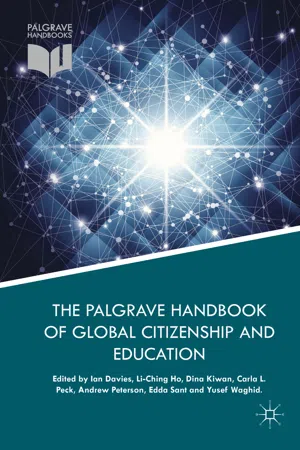Introduction and Overview
Those residing in Australasia, 1 including young Australians and New Zealanders , live at a time in which the benefits and pressures of globalisation are experienced as never before, and in which global citizenship education receives a great deal of international policy attention (see most recently Citizens for Global Education 2014; see also Peterson and Warwick 2014 for an overview). Recognising this policy interest, this chapter presents an analysis of how global citizenship education (hereafter, GCED) is constructed, implemented and experienced in Australian and New Zealander policy, curricula and classrooms. Shaping these contexts is a range of contemporary public policy tensions that interact on local , national and global levels and highlight the significance of global citizenship in Australasia . These include: the impact of migration on cultural diversity ; responses to, and treatment of, those seeking refuge and asylum ; the recognition , reconciliation and representation of Indigenous peoples ; engagement within the Asia-Pacific region ; and concerns about social cohesion . Curricular documents in both Australia and New Zealand engage in different ways with these complexities, but each requires operationalising by schools and teachers in terms of curriculum content and pedagogies employed, particularly given that global complexities are not static but are fluid and dynamic.
As other chapters within this volume attest, GCED is a term that is vital, wide-ranging and contested. In Australasia, as elsewhere, GCED sits across individual subject disciplines, providing flexibility for schools to determine their own approaches. However, such weak disciplinary boundaries (Pike 2008a; Peterson and Warwick 2014) are concomitant with a lack of clear definition for GCED in Australia and New Zealand . A whole host of themes—including globalisation, peace and conflict, social justice , cultural diversity and futures education —not only intersect with GCED in Australasia , but have been developed within contested fields in their own right (human rights education , education for sustainable development , for example).
In this chapter, we begin with some comments about how the political, economic and social context in both Australia and New Zealand informs notions of citizenship/global citizenship. We then move to examining current policy and curricular initiatives in both nations that shape GCED. In the third section, we examine teaching and learning approaches to GCED and argue that the patchy approach in both Australia and New Zealand means that students’ experience of GCED are inconsistent and, at times, lack a critical edge. In the conclusion, we identify some possible futures for GCED in Australasia.
The Political, Economic and Social Contexts
To begin to understand how the Australian and New Zealand education systems frame and enact GCED, it is necessary first to make some initial comments about the historical and contemporary social, political and cultural context of the two countries. As with other nations, sensitive, contested notions of citizenship and identity play out within public debate. How Australians and New Zealanders—including young Australians and New Zealanders—understand themselves as national and global citizens are being shaped and reshaped by the political, economic and social contexts is outlined in this section.
Approximately 3% of Australians identify as being of Aboriginal and/or Torres Strait Islander origin (Australian Bureau of Statistics 2013a), and 15% of New Zealanders identify as Māori (Statistics New Zealand 2013a). Since European colonisation, successive waves of migration have led to Australia and New Zealand being two of the most culturally diverse populations in the world. Over a quarter of both populations have been born in another country , and a further 20% of Australians have at least one overseas-born parent (Australian Bureau of Statistics 2013b), and New Zealand has more ethnicities (213) than there are nations (Statistics New Zealand 2013b). The recent, rapid growth of Asian communities has been a significant feature of this diversity, partly stimulated by shifts in immigration policy 2 from the 1970s onwards in both countries. Four Asian countries are now included in the top 10 birthplaces for Australian migrants, with India the leading birthplace of new migrants 2007–2013 (Australian Bureau of Statistics 2013b). Similarly, New Zealand’s Chinese, Indian and Filipino communities have experienced substantial population increases 2006–2013 (Statistics New Zealand 2013b). Such is the extent of cultural diversity in both nations, that super-diversity now presents a significant policy challenge, and has raised questions about the institutional hegemony of majority ethnic groups (Spoonley 2015).
The political and economic rhetoric and policies of Australian and New Zealand governments over the last three decades have located both countries as Pacific Rim nations looking to forge global diplomatic and trade links across Asia, Europe , the Americas and elsewhere. Australia is a member of the G20 , and both nations are part of the Commonwealth and the Asia-Pacific Economic Co-operation group. Figures for 2015 evidence widespread flows of trade, with China , USA and Japan among both country ’s leading bilateral trade partners (Department of Foreign Affairs and Trade 2016; New Zealand Treasury 2016). This is not to suggest that the relationship between national identity and global connections has been unproblematic or consistent. Indeed, conservative Prime Ministers like John Howard (1996–2007) ...
